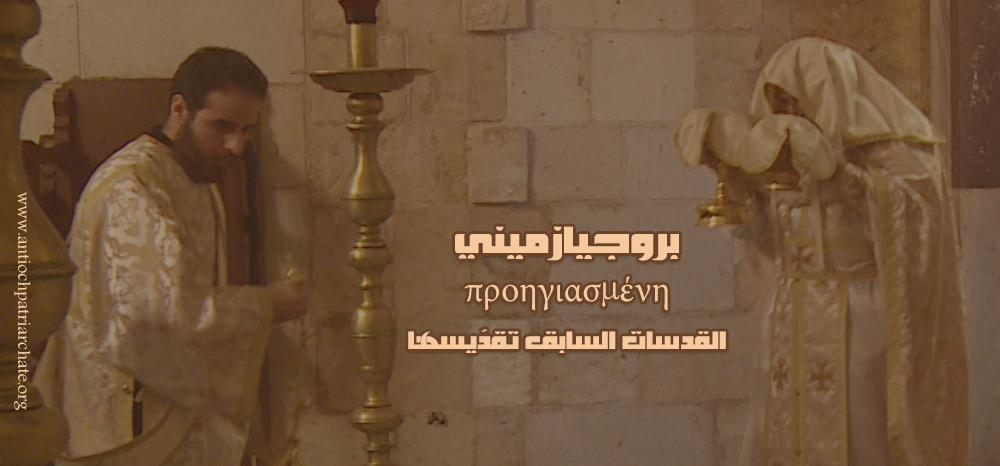
The Liturgy of the Presanctified Gifts
The Liturgy of the Presanctified Gifts
Definition:
The designation “pre-sanctified”, derives from the original Greek Progiasmeni: προαγιασμένη : προ before αγιασμένη sanctified and means “what has been previously sanctified”. This liturgy is a special service celebrated during Great Lent. Its general structure is that of Vespers, with no prayer of sanctification (i.e. the transformation of bread and wine into the Body and Blood of our Lord Jesus Christ), as in the other liturgies. The priest keeps on the Holy Table Precious Gifts which have been sanctified from a previous liturgy, held either on the Saturday or the Sunday before (from here comes the name). These Presanctified Gifts are offered to the faithful for Holy Communion.
This Liturgy is celebrated on Wednesdays and Fridays during Great Lent, either in the morning or in the evening according to the circumstances; on Thursday of the Great Canon (the fifth week of Great Lent) which is known as “Thursday of repentance”; on Monday, Tuesday, Wednesday of the Great Holy Week, and on any other occasions as mentioned in the Typikon.
The Origins of This Liturgy:
It has been strongly believed that this liturgy appeared in Antioch between the 5th and 6th centuries when under patriarch Severus (512-518). Then later on it reached Constantinople in the same century.
The Concept of the Presanctified Liturgy:
For Christianity that the Eucharist, the Holy Communion of the Body and Blood of Christ is normally crucial for the life of the faithful, “He who eats My flesh and drinks My blood abides in Me, and I in him.” (John 6:56). It is worth mentioning that this sacrament has been practiced in the church ever since the first century. Since a Christian cannot live without Holy Communion, the Church followed a certain dispensation (oikonomeia) during Great Lent, which is the consecration of Gifts (epiclesis) on a previous Sunday liturgy, which are kept for Holy Communion in the coming week.
The reason is that the time of the Lent is a time of repentance, a time of return to God, while the Divine liturgy is a time of joy and delight in the Resurrection.
Canons in the Church:
A document from the 7th century mentions the service of the Presanctified Gifts, yet practiced in a manner different from what we do today.
The first Canon by St. Nicephorus (758-829) the patriarch of Constantinople refers to the practice of this liturgy (the pre-sanctified):
“The monks fast on Wednesday and on Friday of the cheese-fare Sunday. After the holy communion, they eat cheese wherever they are.”
Some synodal canons prohibit the celebration of the Divine Liturgy during Great Lent.
- Canon 49 in Laodicea council (343-381) states the following: “It is forbidden to eat Bread during the great lent except on Saturday and Sunday (the day of the Lord)”.
- Canon 52 of the Quinisext Council of 692, also called in Trullo Council because they gathered under the dome of the church in the Imperial palace, states that the Liturgy of the Pre-sanctified should be celebrated during all Lenten days except Saturdays, Sundays, and on the Feast of the Annunciation (March 25).
Explanation:
Preparing the Gifts
The Gifts for the Liturgy of the Presanctified are prepared during the Saturday or Sunday liturgy of the week before.
During Matins, the priest prepares the first Lamb (Amnos) to be sanctified: he cuts it, stabs it, and lays it on the diskos. Then he cuts another Lamb (Amnos) or maybe two or more, according to the need of the week, and repeats what he did for the first Lamb: cutting, lifting and stabbing, reading special prayers for each stage. Then the priest lays them on the Platen (diskos) to the east side of the first lamb so adjacent to each other, and continues the prosthesis (proskomedia) as usual.
During the Divine Liturgy the priest divides only the lamb that will be partaken on that day.
He takes the divided portion and puts it inside the chalice as usual; then he pours the hot water. The other lambs (portions) are lifted for the liturgies of the week. He holds each one with his left hand over the chalice, with the spoon in his right hand. He inserts the spoon into the chalice and lifts it full with the consecrated blood of the Lord Jesus Christ, saying:
“With the emptying of the divine Blood from Thine undefiled and life-giving side, O Master Christ, sacrifice to idols hath ceased, and all the earth doth bring unto Thee the sacrifice of praise.”
Then he pours the holy blood with the spoon overs the cross that he had cut in the lamb by means of the spear during the proskomedia (prosthesis) and says:
"The unity and perfection of the Holy Body and the Holy Blood". Then he puts the lamb upside down in the box, repeating the same act on all the lambs.
An important note:
When the priest blesses the bread and wine during their consecration (the epiclesis), he does not say “make these breads”, but “make this bread”, in singular, for Christ is Indivisible. Later, he lifts all the Lambs together and says: “The Holies are for the holy”.
Structure of the Liturgy of the Presancitified Gifts
The pre-sanctified liturgy is similar to the liturgy of St. Basil the Great, as both start with Vespers.
In this liturgical service, the Offerings (Gifts) are transferred in two stages:
1- First stage: At the end of the Liturgical service, precisely after the Great Litany of Peace, the Gifts are transferred from the Holy Table where they have been kept, to the Table of Oblation.
2- Second stage: after the Litany of Fervent Supplication. The Cherubic Hymn is replaced by: “Now the Powers of Heaven minister invisibly with us. For, behold, the King of Glory enters”.
The Gifts are transferred again from the Table of Oblation to the Holy Table in the midst of the Altar. This is called: “Entrance with the Gifts”. The priest comes out of the Altar from the Northern door, carrying the Holy Body and Blood of Christ, with much reverence, with his head covered. He enters from the Royal doors and places the Gifts on the Holy Table.
Then the choir continues: “Behold, the mystical sacrifice, fully accomplished, is ushered in. In fervent faith let us draw near, that we may become sharers in everlasting life. Alleluia.”
In the end, the faithful partake of the previously sanctified Gifts.
Note: The priest notifies the faithful about transferring the Gifts in both stages by ringing a small bell, inviting them to worship as the Gifts will be transferred.
-The Readings:
During the pre-sanctified liturgy there are two readings: one taken from Genesis, and the other one from Proverbs, and both speak on the creation by God of the world and of humankind, on the fall of humankind and God’s economy (dispensation) of salvation. These two readings have been a part of the teachings to the Catechumens before being baptized on the bright Saturday.
It is good to know now that these teachings used to be dispensed in the afternoon after the 9th hour (equivalent to 3 o’clock in the world). This went on until the beginning of Vespers and the lighting of the candles.
- Light in the Church:
Early Christians used to come for prayer to the church with their lamps about sunset. When it was time to light the lamp, the first deacon (archdeacon) walked out of the sanctuary with 12 other deacons to where the lamps were lit; they would take them to the middle of the church where the deacon would announce with a censer in hand: “The light of Christ shines on you all”. Then the bishop would light the lamps in the Altar and the deacons would light the lamps of the church (this observance is clearly stated in the 11th century).
Then the Liturgy developed. After the first reading from Genesis, the priest would walk out with a candle to the middle of the church and everybody in the church would stand up. The priest would make the sign of the cross by means of the censer saying: “Wisdom, let us attend. The light of Christ shines on you all”.
In a similar way, today, the priest stands with the censer, holding a lit candle before the table on the eastern side and makes the sign of the cross saying: “Wisdom, let us attend”. Then he makes the sign of the cross as he faces the faithful in the church saying: “The light of Christ lights you all”.
It has been mentioned in the early centuries that during the meetings of the table of agape, every believer would stand before the light which represents Christ (I am the light of the world) to sing and chant from the Holy Bible. The same act would take place in the houses.
Notes:
- One of the most ancient songs in the church is “O Gladsome light…” which is sung during Vespers.
- The prayer read at the Ambon is one of the most ancient prayers in the service of this liturgy.

2025-12-06
2025-12-04
Celebrating the Feast of Saint…
2025-12-01
Address of Patriarch JOHN X The…
2025-11-24
Delegation from the Hungarian…
2025-11-22
The Antioch Patriarchate Index…







